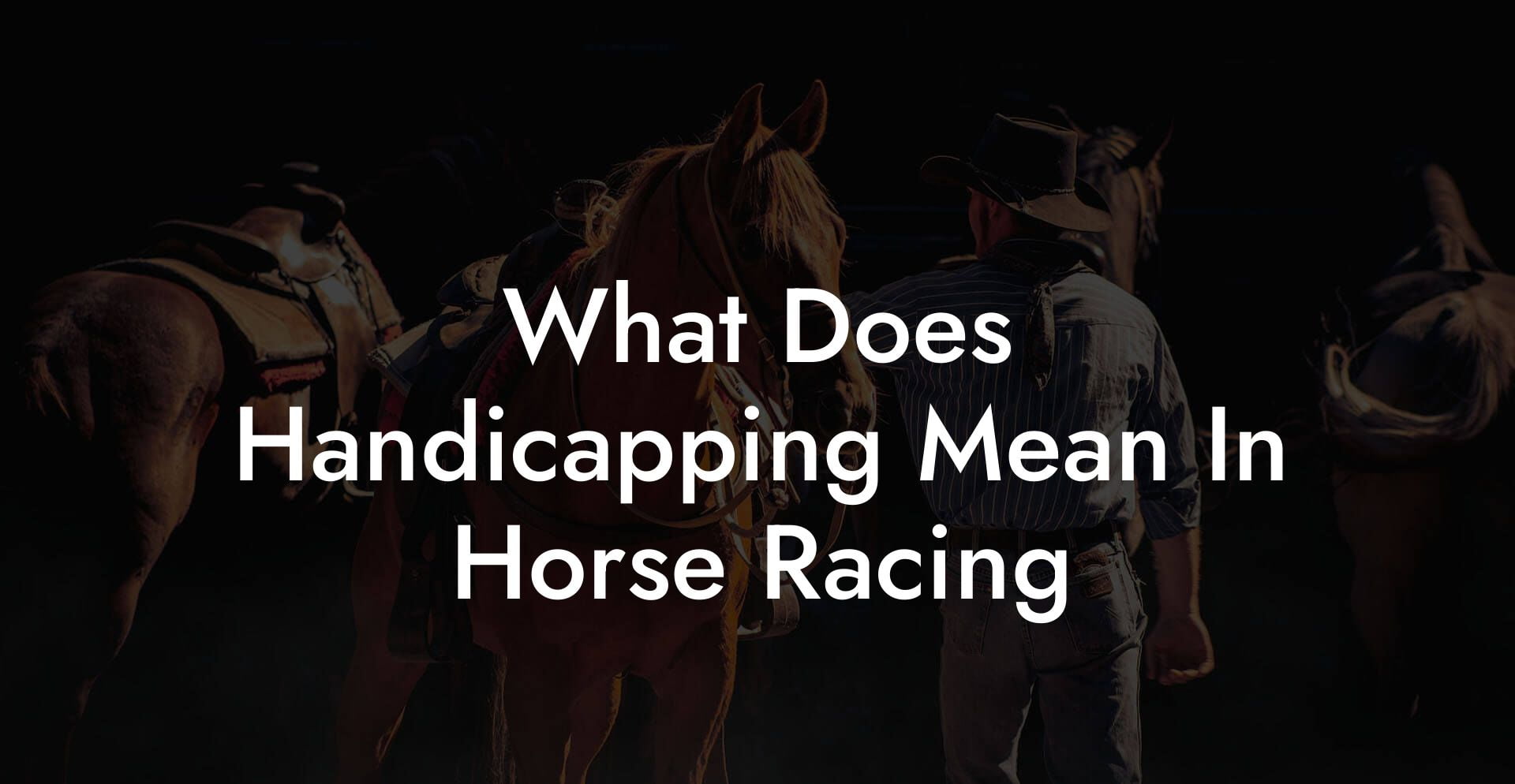Buckle up and get ready to gallop into the thrilling world of horse racing handicapping, a realm where numbers, weights, and tactics collide on the track while offering invaluable insights for every modern equine enthusiast. Whether you've been swiping through your social media feeds looking for the next big race tip, or you're a proud horse owner keen on tapping into strategies that not only predict winners but also optimize your horse’s performance, this guide is your all-access pass. We’re about to break down handicapping in a way that's as refreshing and engaging as your favorite playlist, blending the technical nitty-gritty with a dash of humor and real-world horse care savvy.
Quick Links to Useful Sections
- Understanding Handicapping in Horse Racing: The Basics and the Bold
- The Origins and Evolution of Handicapping in Horse Racing
- Deciphering the Mechanics: How Handicapping Works
- The Weighty Details
- The Role of Odds and Payouts
- The Handicapping Expert: Who Are They and What Do They Do?
- Interpreting Handicapping Data: Pro Tips for the Modern Horse Enthusiast
- 1. Keep an Eye on Speed Figures
- 2. Dive into Recent Form
- 3. Factor in Track and Weather Conditions
- 4. Analyze Jockey and Trainer Statistics
- 5. Combine Multiple Data Points
- Advanced Handicapping Strategies for the Digital Age
- Embracing Technology and Analytics
- The Rise of Predictive Modeling
- Mobile Apps: Your Pocket-Sized Handicapping Assistant
- How Horse Race Handicapping Can Inform Better Equine Care
- Optimizing Training Regimens
- Balancing Diet and nutrition
- Personalizing Weight Management
- Monitoring Recovery and Preventing Injury
- Resources and Community Support: Your Next Steps in the Equine World
- Your Journey to Mastery in Horse Racing Handicapping and Equine Care
- Handicapping in Horse Racing: FAQs for the Inquisitive Enthusiast
Understanding Handicapping in Horse Racing: The Basics and the Bold
At its core, handicapping in horse racing is all about leveling the playing field. Think of it as the ultimate equalizer: a system designed to rank horses based on their performance, assign them weights, and ultimately give every competitor, no matter how storied their track record, a fair shot at crossing the finish line first. This isn’t just a fancy term thrown around by racing pundits; it’s a sophisticated blend of stats, strategy, and a healthy dose of gut instinct.
For those new to the scene, handicapping might sound as cryptic as a high-stakes chess game played at a rodeo. But once you break it down, you'll see that it's essentially about understanding a horse's past performance, physique, and even its personality (yes, horses have character too!) to predict how it will perform under varying conditions. And whether you're a seasoned bettor or a horse owner who wants the best for your equine friend, mastering handicapping gives you an edge in making informed, confident decisions.
In the race of life, knowing how to handicap isn’t just for the professionals. With modern technology and accessible resources, today's Gen-Z and millennial enthusiasts can harness powerful analytical tools paired with timeless observation skills to decode the secrets of the racetrack.
The Origins and Evolution of Handicapping in Horse Racing
Handicapping has a rich history that dates back centuries, evolving alongside the sport itself. In its early days, handicappers, often called “trotters” or “handicappers” back in the day, relied on instinct, local knowledge, and sheer passion to determine how much weight a horse should carry. The idea was simple: adjust the conditions so that every competitor, regardless of natural ability, has a fair chance at victory.
Over time, as horse racing transformed into a more organized sport, so did the art and science of handicapping. With the advent of statistical analysis and modern data collection methods, what was once an art has blossomed into a hybrid of intuition and science. Today, handicappers use advanced metrics like speed figures, past performance data, and even weather and track conditions to form a comprehensive picture of each horse’s potential.
This evolution didn’t just change the game, it redefined it. Handicapping has grown from a local, often informal practice into a high-stakes component of professional sports betting and race strategy. But no matter how high-tech it gets, the essence remains the same: it’s about creating as level a playing field as possible. And while those early handicappers might have relied on gut feelings and a good eye for a promising stallion, today’s approach is a blend of cutting-edge technology and old-school wisdom.
Deciphering the Mechanics: How Handicapping Works
Let’s get into the mechanics of handicapping. Picture the racetrack as an arena where every horse is assigned a weight, a bad weight, or a good weight, that can dramatically influence the outcome. The idea is to compensate for a horse’s natural talent or past performance by adding extra weight or, in some cases, allowing it to carry less, giving every competitor a fighting chance.
The Weighty Details
At the heart of handicapping is the assignment of weights. Horses that have demonstrated superior performance in previous races are often saddled with additional weight. Why? Because carrying more weight tends to slow them down, theoretically balancing out their natural advantages. Conversely, horses that are less proven may get a break with lighter loads, giving them a bit of a boost.
This process isn’t arbitrary, it’s based on rigorous performance data, careful observation, and sometimes a healthy dose of intuition. Handicappers look at factors like:
- Speed Figures: Objective ratings that gauge how fast a horse has run in past races.
- Recent Form: How consistently a horse has performed in its recent outings.
- Distance Aptitude: Some horses shine over shorter distances, while others are built for endurance.
- Track Conditions: Wet or muddy tracks might favor certain racing styles over others.
- Jockey and Trainer Impact: The human element can sometimes be the secret sauce that pushes a horse over the line.
By crunching these numbers and tying them together with a broader understanding of the race dynamics, handicappers create a roadmap that guides bettors, trainers, and even the horses’ owners.
The Role of Odds and Payouts
Handicapping doesn’t operate in isolation, its insights ripple through the betting world. The assigned weights and performance ratings influence the odds offered to the public, which in turn dictate the potential payouts if a horse wins. In a sense, the odds serve as a public barometer of a race’s expected outcome, reflecting collective wisdom (and sometimes collective hype).
Modern betting markets integrate handicapping data into real-time odds adjustments, ensuring that every wager reflects a constantly updated picture of the race dynamics. For the savvy bettor, this means that the more you understand handicapping, the better you can anticipate where the value lies and ultimately, where the winning horse might be found.
The Handicapping Expert: Who Are They and What Do They Do?
If handicapping were a sport in itself, the professionals at the helm would be its MVPs. These experts are part analyst, part fortune teller, and all about leveraging data, experience, and a keen eye for detail. An adept handicapping expert is someone who isn’t intimidated by spreadsheets or the complexities of racetrack conditions, they thrive in them.
So, what does a handicapping expert actually do? Here are some of the key roles they play:
- Data Analysis: They meticulously analyze past performance metrics, adjust for varying race conditions, and even factor in the subtle influences of weather and track surface quality.
- Risk Assessment: Understanding the risk-to-reward ratio of a particular bet is crucial. Experts weigh possibilities, calculating potential returns versus the likelihood of various outcomes.
- Technology Integration: In today's fast-paced world, many handicappers use advanced algorithms, mobile apps, and real-time data feeds to stay ahead of the curve.
- On-Track Intelligence: Beyond numbers, there’s the art of observation. Knowing how a horse behaves before a race can provide insights that raw data might miss.
And don’t forget the subtler aspect: passion. Horse racing is as much about heart as it is about statistics. A great handicapping expert often brings personal insights from years of watching races, riding in the paddock, and living the equestrian lifestyle.
For modern enthusiasts, this means you’re not just taking someone’s word for it, you’re empowered to interpret the data yourself, blend in technology, and develop a personal strategy that suits your unique perspective on the sport.
Interpreting Handicapping Data: Pro Tips for the Modern Horse Enthusiast
Diving into the ocean of handicapping data might seem overwhelming at first, but with the right strategies, it becomes an enlightening adventure. Whether you’re placing your first bet or simply trying to better understand your horse’s performance, here are some tips to help you navigate the numbers like a pro:
1. Keep an Eye on Speed Figures
Speed figures are the heartbeat of handicapping. These numbers, generated from past race performances, provide a snapshot of a horse’s raw ability. When comparing horses in a race, look for consistency in these figures. A horse that posts high numbers regularly is often a strong contender, even if it’s carrying extra weight.
2. Dive into Recent Form
Past performance is a good indicator of future success, but recent form can be even more telling. A horse on a hot streak might defy the odds despite a lower overall ranking. Conversely, if a usually strong competitor is showing signs of fatigue or declining performance, that could be a red flag.
3. Factor in Track and Weather Conditions
Ever notice how some horses seem to thrive in a downpour while others shy away from muddy tracks? Understanding how track conditions affect performance is essential. Check weather forecasts, identify track surfaces, and consider how these variables might shift the handicap dynamics on race day.
4. Analyze Jockey and Trainer Statistics
The human element in horse racing is not to be underestimated. A skilled jockey and experienced trainer can make all the difference, particularly when navigating challenging races. Look at their historical performance records alongside the horses under their care and see if there’s a pattern of success.
5. Combine Multiple Data Points
No single statistic tells the whole story. The real magic happens when you combine speed figures, past form, track conditions, and the influence of the jockey-trainer combo. As you gain expertise, you’ll learn to see patterns and make educated guesses that can elevate your racing IQ.
Armed with these insights, you can transform raw data into strategic decisions, whether it means placing a bet at the right moment, or simply understanding what makes your favorite mare or stallion tick on race day.
Advanced Handicapping Strategies for the Digital Age
For those truly ready to up their game, advanced handicapping strategies blend traditional wisdom with modern technology to create a powerhouse of insights. In today’s digital era, data isn’t just king, it’s an entire kingdom waiting to be explored.
Digital tools and predictive analytics now play a crucial role in shaping handicapping strategies. Here’s how you can harness high-tech tactics to get ahead:
Embracing Technology and Analytics
Gone are the days when handicappers solely relied on pen, paper, and gut instinct. Now, sophisticated algorithms, mobile apps, and interactive databases offer real-time insights that can predict the potential of each horse in a given race. These tools analyze countless variables, from biometric data to track conditions and even social media sentiment, to give you an edge over traditional methods.
The Rise of Predictive Modeling
Predictive modeling uses historical data to forecast future outcomes. By inputting variables like speed figures, jockey performance, weight assignments, and even minor details such as post positions, these models can generate a probability score for each competitor. For those with a knack for numbers, integrating these models into your handicapping routine can provide a more objective angle on race day betting.
Mobile Apps: Your Pocket-Sized Handicapping Assistant
The modern horse racing enthusiast is always on the move, and mobile apps have revolutionized the way we access racing data. Gone are the days of waiting for the morning newspaper. Today, live updates, push notifications, and interactive charts are available at your fingertips, transforming your phone into a high-powered handicapping assistant.
These advanced strategies don’t just help you bet, they empower you with a deeper understanding of each race. And if you're a horse owner, the insights can even inform decisions about training schedules, nutritional adjustments, and overall care routines tailored to your horse’s specific abilities and needs.
How Horse Race Handicapping Can Inform Better Equine Care
Believe it or not, the principles of handicapping extend beyond the betting window and into the everyday care of your horse. As a modern equine enthusiast, you’re not just interested in the races, you care deeply about your horse’s well-being, performance, and longevity. Here’s how understanding handicapping can lead to a healthier, happier horse:
Optimizing Training Regimens
Handicapping isn’t only about predicting outcomes; it’s also about understanding the limits and potential of a horse. By analyzing the weights a horse carries and reviewing its performance metrics, trainers can tailor exercise regimens that build strength without risking injury. Whether you’re managing intensive training schedules or planning a recovery period, these insights help ensure your horse is always at its best.
Balancing Diet and nutrition
Much like a finely tuned engine, a racehorse’s diet plays a critical role in its performance. Handicapping data may provide clues about a horse’s endurance and speed, which are influenced by its nutritional status. By integrating dietary strategies, such as incorporating the right balance of proteins, carbohydrates, and fats, you can support muscle recovery and overall energy levels. Modern nutritionists often recommend supplements and specific feeding schedules designed to optimize performance, something that a savvy handicapping analysis can help fine-tune.
Personalizing Weight Management
One of the central themes of handicapping is the careful calibration of weight. For horse owners, understanding these principles can inform better strategies for weight management. Insights from handicapping can indicate whether your horse might benefit from adjusting its conditioning program or even modifying its diet. It’s about striking a balance, ensuring your horse carries only what’s necessary to stay competitive while also preserving its vitality.
Monitoring Recovery and Preventing Injury
Every race is not just a competition, it’s also a test of stamina and resilience. By studying handicapping trends, trainers can identify when a horse might be overworked or at risk of injury. This allows for timely adjustments in training intensity and recovery protocols. In the long-run, a well-rested, properly conditioned horse has a longevity and performance edge, making it a win-win for both the sport and the animal’s well-being.
Integrating the insights from racing handicapping into your daily horse care routine transforms your relationship with your equine partner. It’s a holistic approach that blends competitive strategy with compassionate care, ensuring that every stride taken on the track is supported by sound health and well-being.
Resources and Community Support: Your Next Steps in the Equine World
Embarking on a journey into the world of horse racing handicapping and comprehensive equine care is exhilarating, and you’re not alone. The digital age provides an abundance of resources, expert communities, and interactive platforms designed to help you sharpen your skills and expand your knowledge.
Online Forums and Social Media Groups: Join vibrant online communities on platforms like Reddit, Facebook, and dedicated horse racing blogs. Here, you’ll find experienced handicappers, trainers, veterinarians, and other horse owners sharing tips, insights, and success stories. From lively discussions on feed optimization to deep dives into the latest in predictive analytics, these communities are hubs of collective wisdom.
Educational Platforms and Webinars: Keep an eye out for online courses, webinars, and podcasts that focus on both handicapping strategies and holistic horse care. Many racing organizations and equine experts offer tutorials and live sessions that break down complex topics into digestible, actionable insights.
Books and Publications: While tweets and quick-fix tips are great, nothing beats a deep dive into the history and science of horse racing handicapping. From classic texts to modern analyses, educational publications can provide a comprehensive overview of how strategies have evolved over the years.
Local Racing Tracks and Equine Clinics: Sometimes, the best way to learn is by experience. Attend local races, visit equine clinics, and talk directly with trainers and veterinarians. Not only will you gain firsthand experience, but you’ll also build relationships with professionals who share your passion.
The key takeaway is that every expert started as a beginner. As you immerse yourself in these resources and connect with like-minded enthusiasts, you’ll soon uncover layers of insight, from advanced statistical models to everyday horse care tips, that bridge the gap between theory and practice.
Whether you’re looking to refine your handicapping strategies or fine-tune your horse care regimen, these resources serve as vital stepping stones on your journey to mastery in both arenas.
Your Journey to Mastery in Horse Racing Handicapping and Equine Care
As you weave your way through the exciting world of horse racing handicapping, remember that it’s not just about predicting winners, it’s about understanding the intricate web of factors that influence performance. From analyzing raw data and diving into advanced predictive models to refining your horse care strategies, every aspect of this journey intertwines to create a more fulfilling, informed, and empowered experience.
Embrace the challenge of mastering handicapping with the same passion you invest in caring for your horse. Each race, each data point, and each training session contributes to a bigger picture, a picture where science meets intuition, and strategy meets heart. By continuously educating yourself, connecting with experts, and applying these insights on and off the track, you not only enhance your chances of betting success but also ensure that your four-legged companion remains at peak performance and health.
The beauty of horse racing lies in its complexity, a sport where every element, whether it’s a sophisticated weight assignment or a well-planned feeding schedule, tells a part of the story. Your journey towards understanding handicapping and improving equine care is just that: a story in progress, full of learning, adaptation, and triumph.
So, lace up your boots (or saddle up, in this case) and take your place at the starting gate. The world of horse racing handicapping is ready for you, a dynamic blend of data, strategy, and soulful horse care. Your quest into this robust arena is more than a pursuit of victory; it’s a journey toward becoming a well-rounded, informed, and empowered participant in one of the most exhilarating sports on the planet.
Gallop forward with confidence, embrace the unexpected twists of every race, and let your passion for horses guide your every decision. Whether you’re analyzing speeds, calculating odds, or simply nurturing your prized steed at home, remember that every step brings you closer to mastery.
Handicapping in Horse Racing: FAQs for the Inquisitive Enthusiast
The world of handicapping is as complex as it is exhilarating. Here are some frequently asked questions that shed light on the most burning topics regarding handicapping in horse racing.
1. What does handicapping mean in the context of horse racing?
Handicapping involves assigning weights to horses based on their past performance, speed figures, and other relevant factors. This process aims to even the playing field by ensuring that stronger horses carry more weight while less proven competitors get a weight advantage.
2. How is the assigned weight determined?
Weights are determined by a combination of factors including speed figures, recent performance, distance suitability, track conditions, and the influence of the jockey and trainer. The goal is to balance the natural abilities of the horses and make the race as competitive as possible.
3. Can I apply handicapping principles if I’m new to horse racing?
Absolutely. While the terminology and data can seem overwhelming at first, modern tools and resources, such as mobile apps and online communities, make it accessible even for newcomers.
4. How does handicapping impact betting odds?
The handicapping process affects the odds by adjusting the perceived performance potential of each horse. This, in turn, informs the betting market and helps determine the payout if a horse wins.
5. What role do track conditions play in handicapping?
Track conditions, such as whether the surface is dry, wet, or muddy, can significantly affect a horse’s performance. Handicappers factor in these conditions to better assess a horse’s chances and adjust weight assignments accordingly.
6. Are advanced statistical models necessary for effective handicapping?
While advanced models can enhance your predictive accuracy, a solid understanding of the fundamentals, like speed figures and recent performance, is essential. Modern technology simply supercharges these traditional methods.
7. Can handicapping insights be applied to horse care and training?
Definitely. The same principles used to evaluate a horse's performance on the track can guide improvements in training regimens, diet, and recovery strategies. This holistic approach ensures that your horse is conditioned for success both on race day and in its everyday care.
8. How can I start learning more about handicapping?
Start with trusted online resources, join equine communities, attend local races, and consider enrolling in webinars or courses focused on horse racing analytics. Over time, as you practice and absorb the information, your understanding will deepen significantly.
9. Is handicapping more of an art or a science?
It’s both. While statistical analysis forms the backbone of handicapping, intuition and experience play equally important roles. The best handicappers blend art with science to make well-rounded predictions.
10. How does handicapping benefit horse owners?
For horse owners, handicapping offers insights into a horse's strengths and weaknesses, informing decisions on training, nutrition, and overall care. It’s a valuable tool for maximizing performance and ensuring long-term health.













